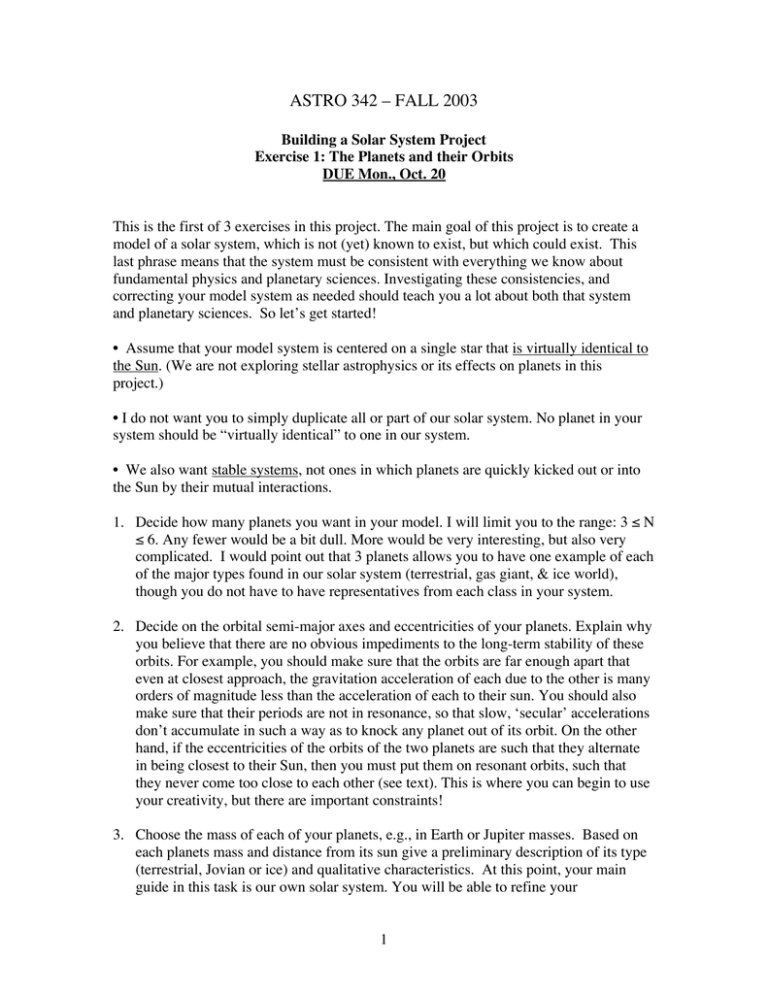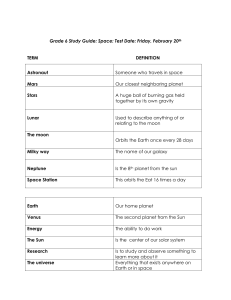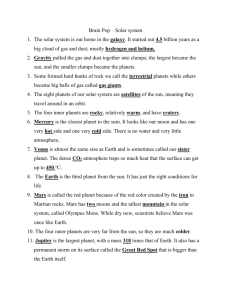ASTRO 342 – FALL 2003
advertisement

ASTRO 342 – FALL 2003 Building a Solar System Project Exercise 1: The Planets and their Orbits DUE Mon., Oct. 20 This is the first of 3 exercises in this project. The main goal of this project is to create a model of a solar system, which is not (yet) known to exist, but which could exist. This last phrase means that the system must be consistent with everything we know about fundamental physics and planetary sciences. Investigating these consistencies, and correcting your model system as needed should teach you a lot about both that system and planetary sciences. So let’s get started! • Assume that your model system is centered on a single star that is virtually identical to the Sun. (We are not exploring stellar astrophysics or its effects on planets in this project.) • I do not want you to simply duplicate all or part of our solar system. No planet in your system should be “virtually identical” to one in our system. • We also want stable systems, not ones in which planets are quickly kicked out or into the Sun by their mutual interactions. 1. Decide how many planets you want in your model. I will limit you to the range: 3 ≤ N ≤ 6. Any fewer would be a bit dull. More would be very interesting, but also very complicated. I would point out that 3 planets allows you to have one example of each of the major types found in our solar system (terrestrial, gas giant, & ice world), though you do not have to have representatives from each class in your system. 2. Decide on the orbital semi-major axes and eccentricities of your planets. Explain why you believe that there are no obvious impediments to the long-term stability of these orbits. For example, you should make sure that the orbits are far enough apart that even at closest approach, the gravitation acceleration of each due to the other is many orders of magnitude less than the acceleration of each to their sun. You should also make sure that their periods are not in resonance, so that slow, ‘secular’ accelerations don’t accumulate in such a way as to knock any planet out of its orbit. On the other hand, if the eccentricities of the orbits of the two planets are such that they alternate in being closest to their Sun, then you must put them on resonant orbits, such that they never come too close to each other (see text). This is where you can begin to use your creativity, but there are important constraints! 3. Choose the mass of each of your planets, e.g., in Earth or Jupiter masses. Based on each planets mass and distance from its sun give a preliminary description of its type (terrestrial, Jovian or ice) and qualitative characteristics. At this point, your main guide in this task is our own solar system. You will be able to refine your 1 understanding of planetary characteristics as we learn more in the course. However, I would not expect you have a terrestrial planet with oceans of liquid water orbiting at 20 AU from the star! (Note: the maximum mass of a planet is now conventionally taken to be about 13 times that of Jupiter. More massive objects are called brown dwarf stars because they can fuse deuterium (heavy hydrogen) early in their evolution.) 4. Complete the bulk characterizations of your planets by choosing tentative values for the rotation period and obliquity of each. Be careful! If the planet orbits very close to its sun its might be locked in synchronous rotation. 5. Now choose the number and characteristics of any moons. In this process you essentially have to repeat all of the above steps. I.e., if you have multiple moons (beloved of science fiction writers!) you must put them on stable orbits. You must also choose the moon masses and characteristics in a consistent way. For example, the moon should be less massive than the planet. As second example, it is not likely that a terrestrial planet orbiting within a few AU of the star has an ice moon. (Soon we will learn precisely why this is so, for now you can refer to the example of a solar system.) 6. Now double check some more things about your moons. (At this point you may decide to have very few moons!) First, unless the moons is orbiting very close to its planet you should check that the gravitational acceleration from the next closest planet, when it is closest to the moon, is many orders of magnitude less than the acceleration of the parent planet. If you have two or moons around one planet, you will also have to check that their orbital perturbations on each other are small. If they are both large moons, this can be very difficult unless they are in one of the few special orbits. By comparison to examples in our solar system, try to estimate whether your moons are in synchronous rotation or not. You might also want to consider the tidal forces of the moon(s) on the parent planet. Good luck and have fun with this! 2







